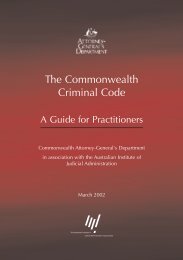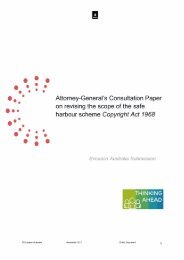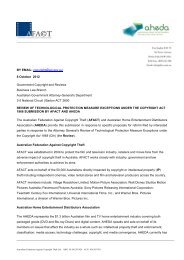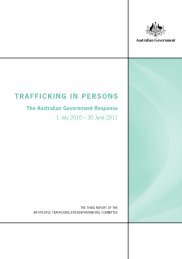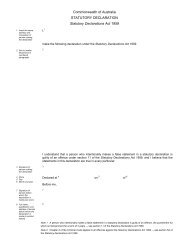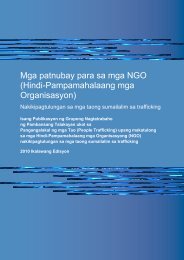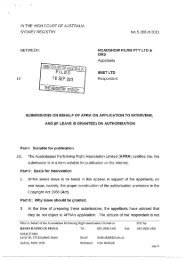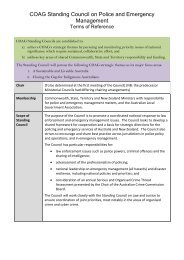Normann Witzleb [PDF 657KB] - Attorney-General's Department
Normann Witzleb [PDF 657KB] - Attorney-General's Department
Normann Witzleb [PDF 657KB] - Attorney-General's Department
You also want an ePaper? Increase the reach of your titles
YUMPU automatically turns print PDFs into web optimized ePapers that Google loves.
20 Both the ALRC and the NSWLRC were concerned to ensure that the privacy interest<br />
was not privileged over other rights and interests. 29 This led them to incorporate the<br />
consideration of countervailing interests into the cause of action. The ALRC proposes<br />
that in determining whether the cause of action was made out, the court must ‘take into<br />
account whether the public interest in maintaining the claimant’s privacy outweighs<br />
other matters of public interest’. 30 It is worth noting that the proposals do no limit the<br />
public interest defence to the implied freedom of political communication, as developed<br />
in High Court jurisprudence 31 , but instead adopt a broad understanding of the public<br />
interest. In the formulation of the NSWLRC, a privacy invasion is actionable if it ‘invaded<br />
the privacy the individual was reasonably entitled to expect in all of the circumstances<br />
having regard to any relevant public interest (including the interest of the public in being<br />
informed about matters of public concern). 32<br />
21 Public interest considerations are also central to the issue of liability in the VLRC<br />
cause of action. However, the VLRC proposal creates a defence where the defendant’s<br />
conduct is in the public interest. In doing so, the onus of proof is cast on the<br />
defendant. 33<br />
Comment<br />
22 There is no doubt that the interest in privacy cannot enjoy absolute protection. In<br />
many situations, countervailing interests will outweigh the plaintiff’s desire for privacy<br />
and, if that is the case, the defendant should not be liable for conduct that interferes<br />
with the plaintiff’s privacy. The statutory cause of action therefore needs to provide a<br />
suitable framework for balancing these competing considerations.<br />
23 Some commentators have concluded from the differences in wording between the<br />
ALRC and the NSWLRC proposals (i.e. that privacy ‘outweighs… the public interest’ as<br />
opposed to ‘having regard to … public interest’) that the NSWLRC formulation sets a<br />
lower standard. 34 However, both proposals require a balancing between the interest in<br />
privacy and countervailing public interest. It is not likely that a plaintiff will be granted a<br />
remedy where the privacy interests are less deserving of protection than the public<br />
interest matters invoked by the defendant.<br />
24 The main point of distinction between the proposals is the onus of proof. In contrast<br />
to the ALRC and the NSWLRC, the VLRC expressed the view that the plaintiff should not<br />
have to prove a lack of countervailing public interest. It was concerned that this would<br />
involve the difficult task of proving a negative. Imposing this onus on the defendant also<br />
29 ALRC Report, at [74.147].<br />
30 ALRC Report, Rec 74-2. This differs from the ALRC Discussion Paper which suggested a defence for<br />
information disclosed as a matter of public interest, see Australian Law Reform Commission, Review of<br />
Australian Privacy Law, Discussion Paper 72, 2006, Proposal 5.5(c).<br />
31 Nationwide News Pty Ltd v Wills (1992) 177 CLR 1; [1992] HCA 46; Lange v Australian Broadcasting<br />
Corporation (1997) 189 CLR 520; [1997] HCA 25.<br />
32 NSW Draft Bill, cl 74(2). Similarly, ALRC Report, Rec 74-2; and at [74.157].<br />
33 VLRC Report, at [7.180].<br />
34 P G Leonhard, ‘Proposals for a statutory cause of action for invasion of privacy in Australia: A brief<br />
comparison’ (2010) 6 Privacy Law Bulletin 42, 46.<br />
9


![Normann Witzleb [PDF 657KB] - Attorney-General's Department](https://img.yumpu.com/26247895/9/500x640/normann-witzleb-pdf-657kb-attorney-generals-department.jpg)

